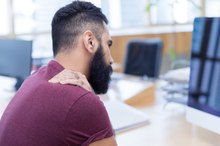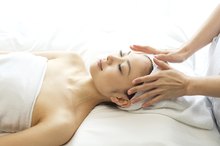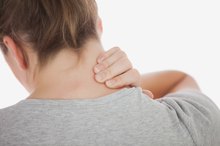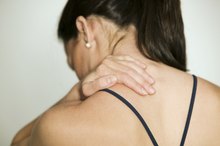Causes of Pain in the Neck & Back of the Head
Pain in the neck and back of the head is a common combination of symptoms 5. The neck is a complicated structure made of bony vertebrae, ligaments, muscles and nerves.
If you are experiencing serious medical symptoms, seek emergency treatment immediately.
Since the neck is connected to the skull, problems in the neck often cause pain in the back of the head as well. There are many causes of pain in the neck and back of the head, ranging from muscle strain to arthritis to uncommon conditions such as meningitis or cancer.
Muscle Strain
Muscle strain occurs when a muscle is stretched or torn. This produces inflammation, swelling and pain. Muscle strain may develop gradually from repeated overuse of the muscle or it may occur suddenly, due to a quick, unusual movement.
Whiplash from an automobile accident or sports injury is a common cause of muscle strain in the neck. As muscles from the neck extend up into the back of the head, pain is often felt in the head as well.
Muscle strain is typically treated by limiting neck movement and applying ice for the first 2 to 3 days, followed by heat. Nonsteroidal anti-inflammatory drugs (NSAIDs), such as ibuprofen (Advil, Motrin) or naproxen (Aleve), may also be helpful.
- Muscle strain occurs when a muscle is stretched or torn.
- Muscle strain is typically treated by limiting neck movement and applying ice for the first 2 to 3 days, followed by heat.
Poor Posture
How Does Prednisone Treat TMJ?
Learn More
Many Americans spend much of their days hunched over a computer or desk. Poor posture can cause abnormal stress on ligaments and muscles in the neck, resulting in pain in the neck and back of the head.
When poor posture continues for a prolonged time, the muscles may become weak and tight. Sometimes trigger points develop in the muscles.
These small areas of firm muscle — also called muscle knots — are extremely sensitive, producing severe pain when touched. This pain is felt at the trigger point and may extend to other areas as well.
Pain from poor posture is treated like a muscle sprain, as well as by learning techniques to improve posture. Trigger points may be injected with a local anesthetic or corticosteroid.
- Many Americans spend much of their days hunched over a computer or desk.
- Pain from poor posture is treated like a muscle sprain, as well as by learning techniques to improve posture.
Arthritis
Pain may be caused by inflammation of joints located between each vertebrae in the neck or between the highest vertebra and the skull.
Osteoarthritis is the most common type of joint inflammation affecting the neck. It's a wear-and-tear form of arthritis, in which repetitive movements eventually lead to joint destruction.
**Osteoarthritis of the spine often produces bony outgrowths called osteophytes, or bone spurs, that can press on nerves or other tissues, causing pain.
When severe, these outgrowths may press on the spinal cord. This can result in pain or other nerve symptoms in the arms, as well as weakness in the legs, balance problems or altered bowel or bladder function. **
NSAIDs are commonly used to improve osteoarthritis pain. Joint injections, epidural steroids and surgery are options when NSAIDs provide insufficient pain relief.
- Pain may be caused by inflammation of joints located between each vertebrae in the neck or between the highest vertebra and the skull.
- This can result in pain or other nerve symptoms in the arms, as well as weakness in the legs, balance problems or altered bowel or bladder function.
Herniated Disc
Signs & Symptoms of a Strained Sternocleidomastoid Muscle
Learn More
A herniated disc occurs when part of the disc located between adjacent vertebrae is pushed out of its usual location. This may develop gradually over time as part of a wear-and-tear process or suddenly as a result of an injury.
The displaced disc material can produce pain by directly pressing on nerves arising from the spinal cord or by producing inflammation in the area. In the upper neck, nerves from the spinal cord travel upwards, so pain may extend into back of the head.
In the lower neck, nerves travel into the arm, so pain may extend into the shoulder and arm. In addition to pain, nerve irritation resulting from direct pressure or inflammation may produce numbness, tingling or weakness.
- A herniated disc occurs when part of the disc located between adjacent vertebrae is pushed out of its usual location.
- In the lower neck, nerves travel into the arm, so pain may extend into the shoulder and arm.
Other Causes
Meningitis — inflammation of the membranes surrounding the brain and spinal cord — may also produce pain in the neck and back of head. Meningitis is usually caused by an infection. In addition to pain, the neck is typically very stiff.
Other common symptoms include a fever, nausea, vomiting and drowsiness.
Rarely, tumors occur in and around the neck, often within the vertebrae.
The tumors may originate in the neck or spread to the neck from other parts of the body. Pain caused by a tumor is typically constant and worsens over time.
Other symptoms will depend on whether the tumor grows into or presses on nerves or the spinal cold itself. Unexplained weight loss, loss of appetite and fatigue are other signs of a possible tumor.
- Meningitis — inflammation of the membranes surrounding the brain and spinal cord — may also produce pain in the neck and back of head.
Seeking Medical Attention
See your doctor if you have pain that extends into your shoulder or arm, lasts more than a few days or is accompanied by symptoms suggestive of a tumor.
Seek immediate medical attention if your pain is severe, or if you have any numbness, tingling, weakness, balance problems or changes in bladder or bowel function. Also obtain prompt medical care if your neck and head pain is due to an injury or if you have significant neck stiffness or other symptoms suggestive of meningitis.
Reviewed by Mary D. Daley, M.D.
- See your doctor if you have pain that extends into your shoulder or arm, lasts more than a few days or is accompanied by symptoms suggestive of a tumor.
- Also obtain prompt medical care if your neck and head pain is due to an injury or if you have significant neck stiffness or other symptoms suggestive of meningitis.
Related Articles
References
- American Academy of Orthopedic Surgeons: Neck Pain
- American Academy of Orthopedic Surgeons: Herniated Disc
- American Family Physician: An Approach to Neck Pain for the Family Physician
- American Family Physician: Radiologic Evaluation of Chronic Neck Pain
- Merck Manual Professional Version: Evaluation of Neck and Back Pain
- American Academy of Orthopedic Surgeons. Cervical Fracture (Broken Neck). Reviewed December 2013.
- Moley PJ. Evaluation of Neck and Back Pain. Merck Manual. Updated August 2019.
- Cleveland Clinic. Think You Might Have Whiplash? Know the Symptoms. Updated January 2, 2017.
- Singh S, Kumar D, Kumar S. Risk factors in cervical spondylosis. J Clin Orthop Trauma. 2014;5(4):221-6. doi:10.1016/j.jcot.2014.07.007
- American Academy of Orthopaedic Surgeons. Cervical spondylosis (Arthritis of the Neck). Updated August 2015.
- ScienceDirect. Discogenic Pain: Treatment of Lumbar Discogenic Pain. 2009.
- Columbia University Department of Neurology. Cervical Spondylosis.
- Touma J, May T, Isaacson AC. Cervical Myofascial Pain. Treasure Island, FL: StatPearls Publishing. Updated September 13, 2019.
- World Health Organization. Spinal Cord Injury. 2013.
- Centers for Disease Control and Prevention. Meningococcal Disease: Signs & Symptoms. Updated June 7, 2017.
- National Institute of Neurological Disorders and Stroke. Meningitis and Encephalitis Fact Sheet. Updated August 13, 2019.
- Stanford Children's Health, Lucile Packard Children's Hospital. Meningitis in Children.
- University of Southern California. Cervical Spine Infections.
- Cleveland Clinic. Salivary Gland Cancer. Updated October 13, 2018.
- Morris NA, Merkler AE, Gialdini G, Kamel H. Timing of incident stroke risk after cervical artery dissection presenting without ischemia. Stroke. 2017;48(3):551-555. doi:10.1161/STROKEAHA.116.015185
- Cleveland Clinic. Cervical (Carotid or Vertebral) Artery Dissection. Updated May 24, 2019.
- Eubanks JD. Cervical radiculopathy: nonoperative management of neck pain and radicular symptoms. Am Fam Physician. 2010;81(1):33-40.
- Khare S, Seth D. Lhermitte's sign: The current status. Ann Indian Acad Neurol. 2015;18(2):154-6. doi:10.4103/0972-2327.150622
- American Academy of Orthopedic Surgeons. Cervical Radiculopathy: Surgical Treatment Options. Updated June 2015.
- American Academy of Orthopedic Surgeons. Cervical Fracture (Broken Neck). Reviewed December 2013.
- Chow AW. (2018). Deep neck space infections in adults. Durand MJ, ed. UpToDate. Waltham, MA: UpToDate Inc.
- Cohen SP. Epidemiology, diagnosis, and treatment of neck pain. Mayo Clinc Proc. 2015 Feb;90(2):284-99. doi:10.1016/j.mayocp.2014.09.008
- Isaac Z, Kelly HR. (2018). Evaluation of the adult patients with neck pain. Atlas SJ, ed. UpToDate. Waltham, MA: UpToDate Inc.
- Martinez-Perez R, Fuentes F, Alemany VS. Subaxial cervical spine injury classification system: is it most appropriate for classifying cervical injury? Neural Regen Res. 2015 Sep;10(9):1416-7. doi:10.4103/1673-5374.165508
Writer Bio
Dr. Blake Biddulph received his chiropractic degree from Parker College of Chiropractic in Dallas in 2007 and has been practicing as a chiropractic physician in Provo, Utah, ever since. He has a special interest in spinal rehabilitation and treats patients with a variety of neck and back conditions. He has been writing health-related articles and newsletters for several years.









